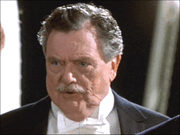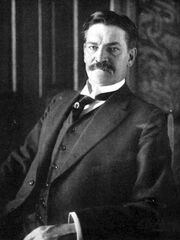Degrassi Fan (talk | contribs) No edit summary |
Degrassi Fan (talk | contribs) No edit summary |
||
| Line 20: | Line 20: | ||
===Aftermath and death=== |
===Aftermath and death=== |
||
Gracie never recovered from the ordeal. Although he survived the sinking, he did not survive the year. His health was severely affected by the hypothermia and physical injuries he suffered, and he died of complications of diabetes on December 4, 1912, less than eight months after the sinking. He was buried at Woodlawn Cemetery in the Bronx, where many of his fellow survivors, as well as family members of victims, attended his funeral. He was the first adult survivor to die. |
Gracie never recovered from the ordeal. Although he survived the sinking, he did not survive the year. His health was severely affected by the hypothermia and physical injuries he suffered, and he died of complications of diabetes on December 4, 1912, less than eight months after the sinking. He was buried at Woodlawn Cemetery in the Bronx, where many of his fellow survivors, as well as family members of victims, attended his funeral. He was the first adult survivor to die. |
||
| + | |||
| + | ==Sources== |
||
| + | *{{Wikipedia Link|Archibald Gracie}} |
||
[[Category:Characters]] |
[[Category:Characters]] |
||
[[Category:1912 Characters]] |
[[Category:1912 Characters]] |
||
Revision as of 23:08, 2 June 2013

Colonel Gracie
Colonel Archibald Gracie IV (January 17, 1859 – December 4, 1912) was an American writer, amateur historian, real estate investor, and survivor of the sinking of the RMS Titanic. He survived the sinking by climbing aboard an overturned collapsible lifeboat, and wrote a popular and valuable book about the disaster which is still in print today.
In James Cameron's 1997 film, Titanic, Archibald Gracie was portrayed by Bernard Fox. Fox also portrayed lookout Frederick Fleet in the 1958 film, A Night to Remember.
RMS Titanic
Aboard the Titanic

Archibald Gracie in 1912
Gracie boarded the Titanic at Southampton on April 10, 1912 and was assigned first class cabin C51. He spent much of the voyage chaperoning various unaccompanied women, including Mrs. Helen Churchill Candee, Mrs. E.D. (Charlotte) Appleton, Mrs. R.C. (Malvina) Cornell and Mrs. J.M. (Caroline) Brown. He also spent time reading books he had found in the first class library, socializing with his friend J. Clinch Smith, and discussing the Civil War with Isidor Straus. He was known among the other first-class passengers as a tireless raconteur who had an inexhaustible supply of stories about Chickamauga and the Civil War in general.
On April 14, Gracie decided that he had neglected his health and spent some time in physical exercise on the squash courts and in the ship's swimming pool. He then attended divine services, had an early lunch, and spent the rest of the day reading and socializing. He went to bed early, intending on an early start the next morning on the ship's squash courts.
Sinking
At about 11:45 pm ship's time Gracie was jarred awake by a jolt. He sat up, realized that the ship's engines were no longer moving, and quickly dressed, putting on a Norfolk jacket over his regular clothes. Reaching the Boat Deck, he realized that the ship was listing slightly; he returned to his cabin to put on his life-jacket and on the way back found the women he had been chaperoning. He escorted them up to the boat deck and made sure that they entered lifeboats. He then retrieved blankets for the women in the boats and Smith assisted Second Officer Charles Lightoller in filling the remaining lifeboats with women and children.
Once the last regular lifeboat had been launched at 1:55 am on the 15th, Gracie and Smith assisted Lightoller and others in freeing the four Englehardt collapsible boats that were stored on top of the crew quarters and attached to the roof by heavy cords and canvas lashings. Gracie had to lend Lightoller his penknife so that the boats could be freed. The men were able to launch Collapsibles "C" and "D" and free Collapsible "A" from its lashings, but while they were freeing Collapsible "B" from its place the bridge was suddenly awash. Gracie later wrote about the moment:
- My friend Clinch Smith made the proposition that we should leave and go toward the stern. But there arose before us from the decks below a mass of humanity several lines deep converging on the Boat Deck facing us and completely blocking our passage to the stern. There were women in the crowd as well as men and these seemed to be steerage passengers who had just come up from the decks below. Even among these people there was no hysterical cry, no evidence of panic. Oh the agony of it.
As the fore part of the ship dipped below the surface and the water rushed towards them, Gracie jumped with the wave, caught a hand hold, and pulled himself up to the roof of the bridge. The undertow caused by the ship's sinking pulled Gracie down; he freed himself from the ship and rose to the surface near the overturned Collapsible "B". Gracie scrambled onto the overturned lifeboat along with a few dozen other men in the water. His friend Clinch Smith disappeared; his body was never found.
As the night wore on, the exhausted, freezing, and soaking wet men aboard the overturned Collapsible "B" found it almost impossible to remain on the slick keel. Gracie later wrote that over half the men who had originally reached the collapsible were claimed by exhaustion or cold and slipped off the upturned keel during the night. As dawn broke and it became possible for those in other lifeboats to see them, Second Officer Lightoller (who was also on the collapsible, along with Wireless Operator Harold Bride) used his officer's whistle to attract the other boats' attention; eventually lifeboats Nos. 4 and 12 rowed over and took the remaining men off the overturned boat. Gracie was so tired that he was unable to make the jump himself and was pulled into lifeboat No. 12, the last to reach RMS Carpathia when that ship, captained by Arthur Henry Rostron, arrived on the scene.
Aftermath and death
Gracie never recovered from the ordeal. Although he survived the sinking, he did not survive the year. His health was severely affected by the hypothermia and physical injuries he suffered, and he died of complications of diabetes on December 4, 1912, less than eight months after the sinking. He was buried at Woodlawn Cemetery in the Bronx, where many of his fellow survivors, as well as family members of victims, attended his funeral. He was the first adult survivor to die.
Sources
Archibald Gracie on Wikipedia